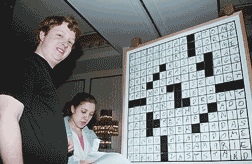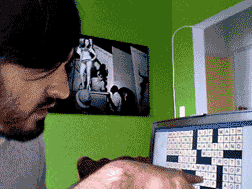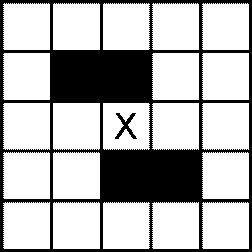 |
|||||||||||
|
|||||||||||
|
|||||||||||
The Puzzler Laid Bare
|
|||||||||||
 |
Tyler Hinman’s winning grin and grid at 2006 American Crossword Tournament, above.Frances Hansen, at below, the dean of crosswords, inserted her personality into her puzzles, including an original poem in her annual Christmas crossword in The New York Times. |
 |
Making the Puzzler
I began making crosswords as a hobby the summer of 2004 after solving for about a year. I was pushed to it after I joined the friendly listserv at cruciverb.com, home to frequent conversations about language. It soon proved difficult to hang out there and not want to try my hand at construction.
Less than two weeks after I joined the cruciverb list, the greatest living constructor, Frances Hansen, passed away. An outpouring of testimonials to her legacy followed, causing me to find and solve some of her best puzzles. I was amazed and inspired. Something of a rogue, Hansen had stubbornly inserted her own personality into her work, including her annual Christmas crossword in The New York Times featuring an original poem. Posthumously, she became my idol.
Meanwhile, my own work progressed slowly. Effort number one was drawn up on an Excel spreadsheet, on company time, and filled with forced, nonsensical entries like GBTA, (Great Britain Teachers Association?) It did not have a theme. Its key feature was four unchecked letters. To cruciverbalists, those are letters, nearly surrounded by blocks, that have an across word going through them, but no down word; Or vice versa (see image on page 5). By accident, these letters happened to be H, O, L and A, spelling HOLA.
This puzzle was unsellable for too many reasons to mention. But, unaware of this and perhaps unconcerned, I emailed the listserv to see if anyone felt like exchanging critiques.
The famous mentor and Times mainstay Nancy Salomon responded that she would be willing to look at my stuff. I was honored, and for the next few months, I sent her every grid I made. There were a lot, perhaps three a week, by the end.
She picked the HOLA puzzle apart without mercy. There was just one glimmer of encouragement: I had less junk in the fill than most beginners. That was more than enough to keep me going.
I sold my first puzzle to USA Today in September, 2004. The editor said it would run in October. This was an exciting moment, and I thrilled to tell my friends and family. I sold another to the L.A. Times soon after; it was scheduled to run on my birthday, November 9. My checker insisted I also try The New York Times, so I sent three puzzles to Will Shortz in November. Shortz is notoriously backlogged, and it can take months to hear back about a first submission. So I waited. Meanwhile, I was selling more and more puzzles to other outlets, including the New York Sun and Universal Syndicate. I was something like eight for eight, and feeling very confident.
By the way, Will Shortz eventually replied, after about six months. He accepted one submission and rejected two. I have published many puzzles in The New York Times since then; once Shortz knows your work, the turnaround time is significantly reduced.
Puzzling a New Generation
A lot of my friends enjoyed solving crosswords. But The New York Times puzzle isn’t exactly designed for us. A hip clue might appear from time to time, depending on the constructor, but more frequent were clues about old racehorses or puns on the names of actresses from the 1950s. Wouldn’t it be worthwhile to write a puzzle for a younger crowd?
So I pitched the idea to the San Francisco Bay Guardian. Amazingly and immediately, the very hip alternative paper bit. In mid-December, 2004, I began writing a weekly puzzle for them, first on a trial basis and then permanently. The clues were West Coast-centric, and stacked with references to bands and movies that had just come out. The first theme was the landmark rap group N.W.A. — not the most contemporary reference, but certainly more familiar in a nostalgic sense to my generation. I doubt that Eazy-E and Dr. Dre had ever been the subject of a crossword before.
Soon I started pitching the idea to other papers, including the Chicago Reader, Detroit Metro Times and Washington City Paper, which all signed on. My hook was geographic specificity, and that turned out to be enough of a hook to make the feature stand out.
Xword now has about 10 syndicated clients in the U.S. and Canada. I had a brief stint with the Village Voice, which ended when the paper was bought by a large conglomerate, New Times Media. Now I also edit a separate puzzle in the satiric Onion’s A.V. Club, its straight film, music, food review section.
Puzzling Rewards
Writing crosswords is possibly the most addictive and rewarding hobby on the planet. There is nothing like getting an e-mail from Will Shortz telling you that he’s accepted your first puzzle, a pleasure that pales in comparison to seeing your name in The New York Times Sunday magazine. Even before you get published, trying out grids and writing crosswords that your friends enjoy solving is great. For the first year or more, I couldn’t stop, and I am still happy every time I sit down to construct.
It is my hope that solvers will form a mental picture of who I am when they solve my puzzles, and conceive of their experience as a battle of wits. You can even get mad at me if you need to. Whatever. Just as long as my presence backstage is not obscured, because the heavens open up when, doing a crossword, one realizes that they are on the same wavelength as the constructor. The best compliment I ever received came from a reader who wrote, “I’ve never noticed who edits crossword puzzles until these.”
Twenty-six-year-old Ben Tausig, a PhD student in Ethnomusicology at New York University, bedevils you weekly with Bay Weekly’s Xword. As well as publishing a weekly Xword in newspapers throughout the U.S. and Canada, he is slated to publish two books in 2007: a puzzle book for kids entitled Mad Tausig vs. The Interplanetary Puzzling Peace Patrol (April) and Gonzo Crosswords from the Village Voice (October).
|
Current Issue \\ Archives \\ Subscriptions \\ Clasified Advertising \\ Display Advertising |


